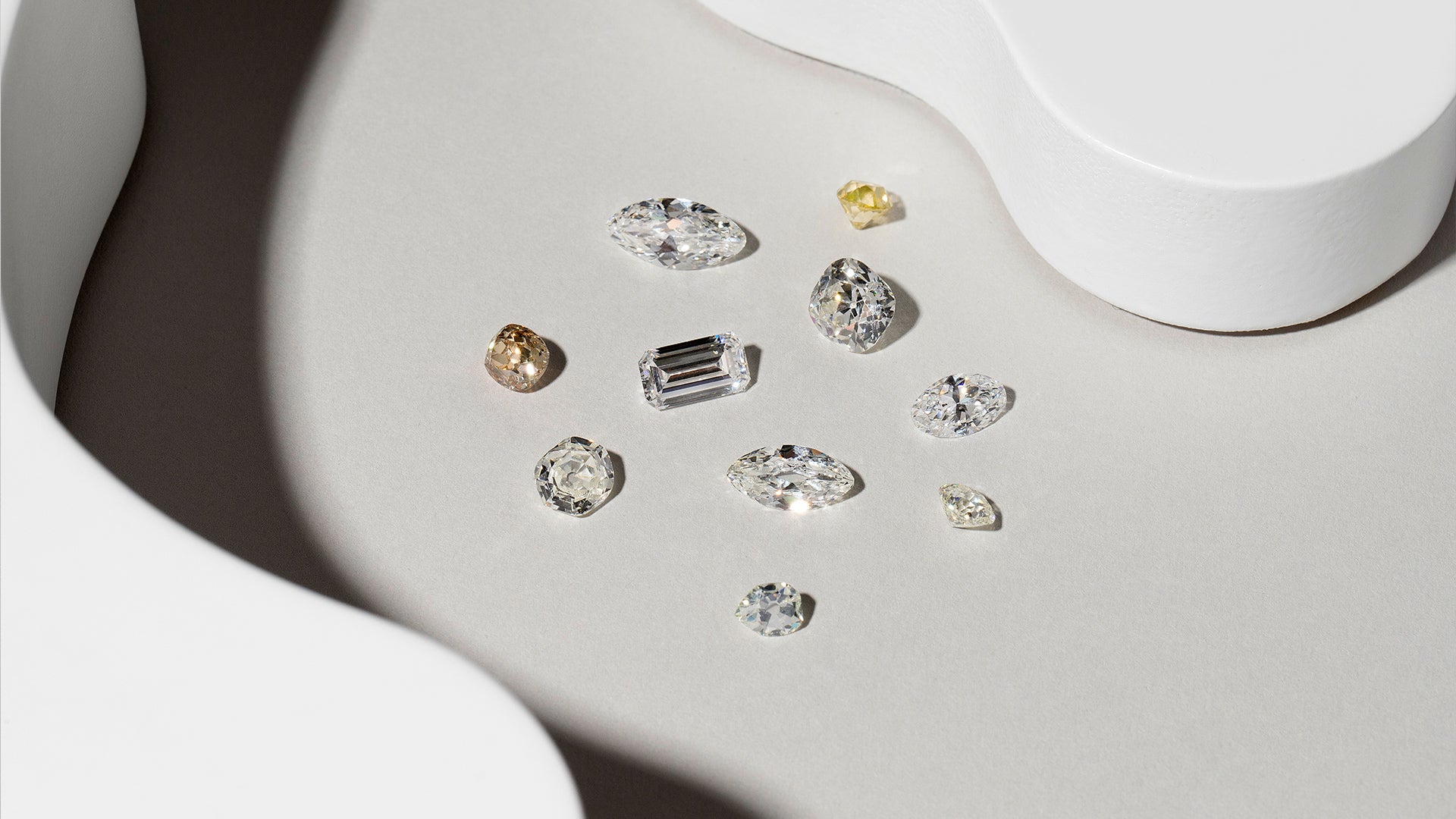We give new meaning to finding "a rare gem." We search for the most unusual modern and antique cuts available within our network of trusted and talented suppliers and strive to know as much as possible about the supply chain of every stone that makes its way into a piece of Mociun jewelry.
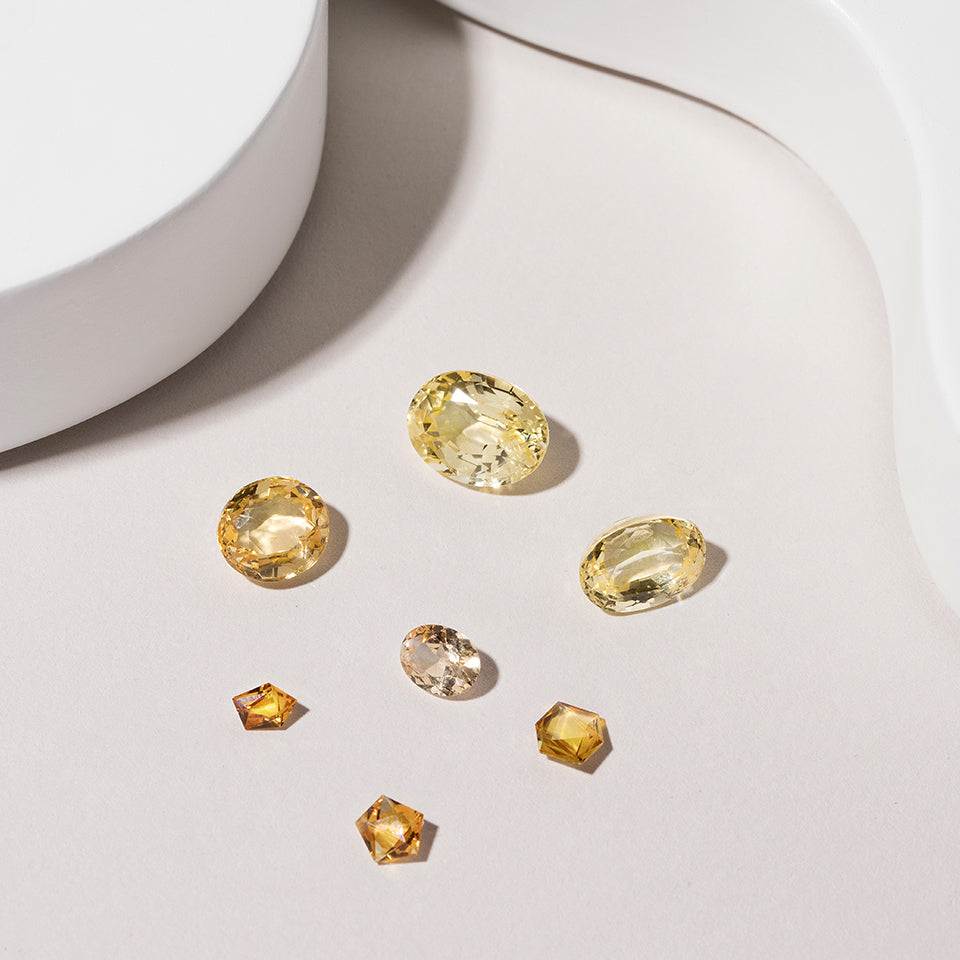
Ethics & Responsibility
Collapsible content
Our Ethical Approach
We take great care to build strong relationships with suppliers who share our philosophies on environmental protection, fair labor, social responsibility and making positive contributions to the communities where our stones come from. Because fine jewelry is especially valuable and the materials are not disposable, we all work to recycle and upcycle as much as possible in order to lower our impact on the environment. Furthermore, we extend our insight from suppliers to our clients to provide as much transparency as possible on every piece we create.
On Newly Mined Diamonds
We exclusively purchase our newly mined diamonds from legitimate sources that are not involved in funding conflict in compliance with United Nations Resolutions. Our sellers guarantee their diamonds are conflict-free.
On Antique Diamonds
We love upcycling antique stones because the process has no environmental impact, but it can be difficult to trace a stone's origin and age once it is taken out of its original setting. While today's standards on procuring stones is much more detailed and advanced than they were years ago, we will always dig into any stone's history and share as much information as we can.
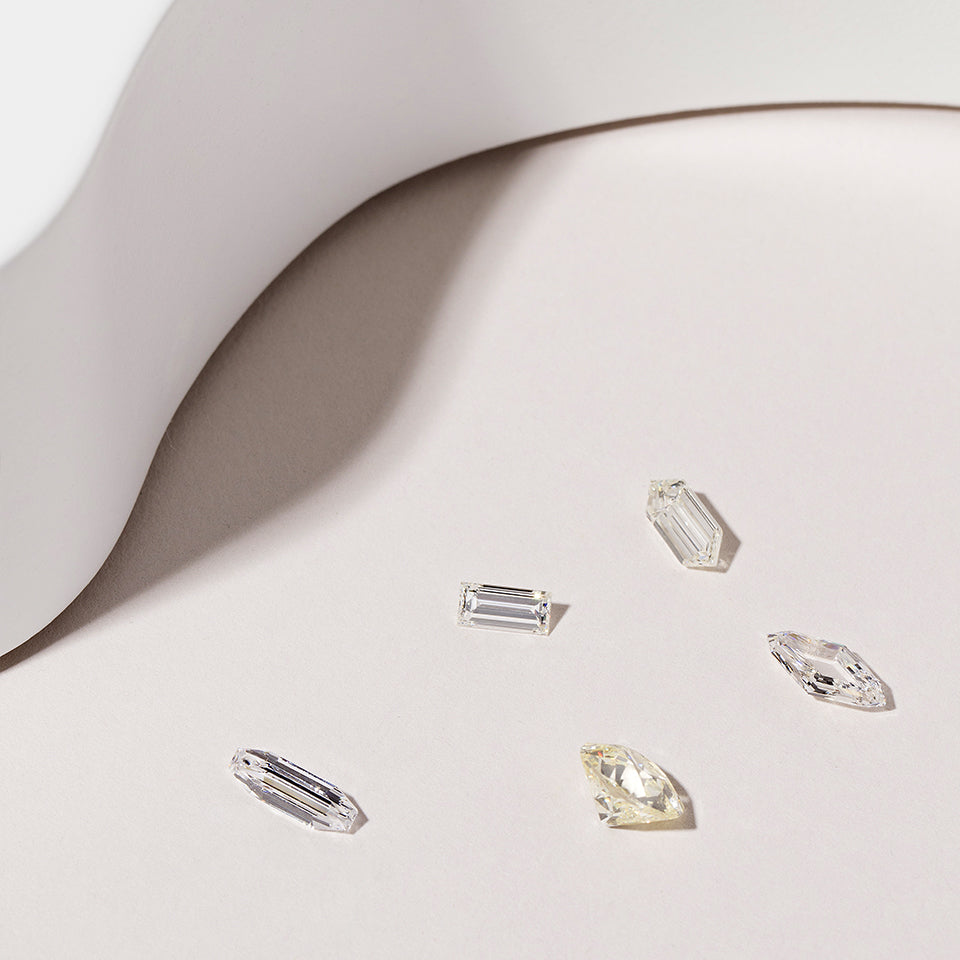
Diamonds: Overview
Collapsible content
Description
Diamonds symbolize purity, fidelity and everlasting love and have long been regarded as the most popular gemstone for engagement rings. We always search for the most striking, rare cuts and try to upcycle as much as possible. Our collection mostly focuses on natural white and champagne diamonds, plus a range of natural and irradiated colored diamonds.
Origins
Our diamonds come from various mines around the world, including Australia, Canada, Botswana, South Africa and Nigeria, and are sourced from our network of trusted dealers. It can be challenging to know the exact origins of each diamond, especially if it is upcycled, but we always provide as much information as possible and work with trusted dealers who strive for the same standards of transparency. If you have questions about a specific piece, please contact our store.
Care
Diamonds are among the hardest materials on Earth and can damage adjacent, softer jewelry, such as an opal. A loose diamond can also damage its metal setting, so check for loose stones regularly and tighten settings as needed. Clean with jewelry cleaner and a soft brush. For more information, visit our Care Guide.
DIAMONDS: THE 4CS
The value of a diamond is based on these four "C" qualities set by GIA (Geological Institute of America).
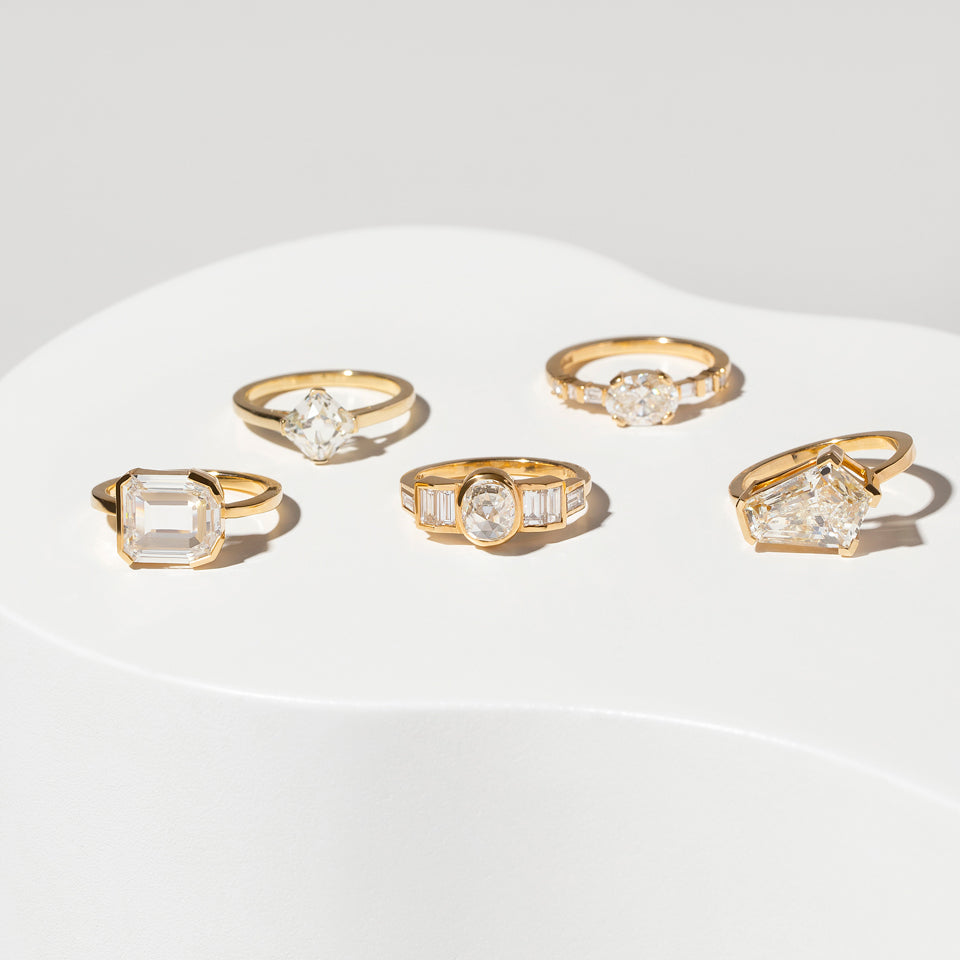
Collapsible content
Carat
A diamond is weighed in carats, and each metric carat is equal to 200 milligrams. The price of a diamond increases along with carat weight because larger diamonds are more rare, but two diamonds of equal carat weight can have very different values (and prices) depending on the other three Cs.
Cut
The most complex quality to analyze of the 4Cs, the cut of a gemstone includes seven components: the overall appearance is determined by a gemstone's brightness, fire and scintillation, while the design and craftsmanship rests on weight ratio, durability, polish and symmetry.
Color
A diamond can range from having no hue or slight hints of yellow or brown. Color is measured in the GIA grading scale from D to Z: D represents a colorless diamond, and the scale increases in presence of color to the letter Z, which has more light yellow or brown.
Clarity
No diamond is perfectly pure, but the closer it comes, the higher its value. Most inclusions (internal features) and blemishes (surface irregularities) are too small to be seen by anyone other than a trained diamond grader, but increased clarity greatly affects diamond price per carat.
Grading Colored Gemstones
While there is no standardized grading system for colored gemstones like sapphires and emeralds, several variables are considered to determine the value. Color is one of the most important factors and can be analyzed by its hue, tone (lightness vs. darkness) and saturation (the hue’s intensity). Origin and treatment also impact value.
Clarity is also a significant factor, but the standards for colored gemstones are different from those of a diamond. Gemologists will grade most colored stones as “eye clean” (showing no inclusions to the naked eye), slightly included, moderately included or heavily included. However, inclusions are tolerated as long they do not compromise the beauty of the stone.
We will always source the most unusual, striking gemstones for our clients while carefully considering all standards and variables.
We strive for transparency. Finding out more about the story behind your jewelry should be as easy as wearing it.
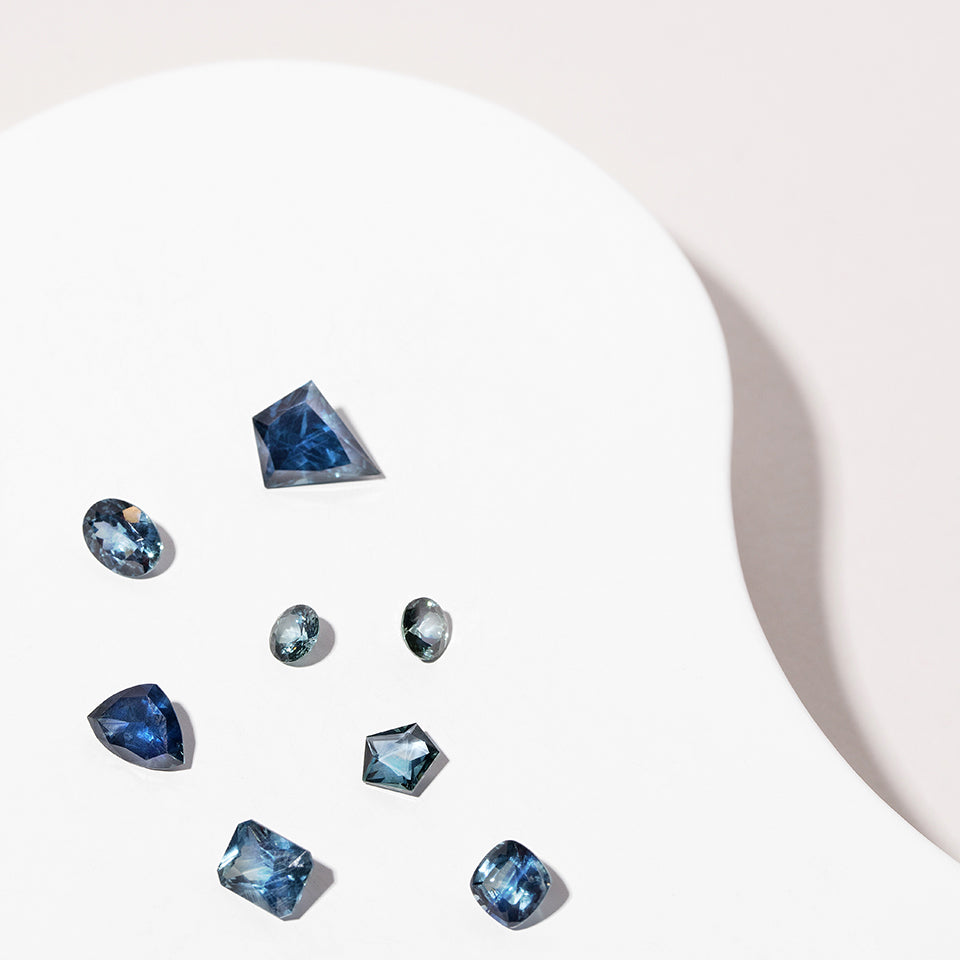
Sapphires
Collapsible content
Description
Sapphires, the September birthstone, symbolize nobility, truth, sincerity and faithfulness. While traditionally associated with the color blue, sapphires come in every color of the rainbow, including yellow, peach and purple. Sapphires and rubies are scientifically same mineral. Rubies are specifically a deep pink to red color. Some sapphires even naturally show two or three distinct colors in a single gem; these are known as bicolor or kaleidoscope sapphires and have been some of our favorite gems to incorporate in our iconic stone cluster arrangements.
Origins
Our sapphires come from a variety of sources including Malawi, Australia, Sri Lanka and Montana, USA. We are proud to work with Montana sapphires because of the relatively small amount of material coming from these mines and the strict environmental standards these mines adhere to. At the time of mining, our sapphires originating from Chimwadzulu Hill in Malawi helped finance the community's hospital and elementary school.
Care
Sapphires are among the most durable of gemstones, making them a safe choice for engagement rings. Clean your sapphire with jewelry cleaner and a soft brush. If you have questions about caring for your sapphire, please contact our store.
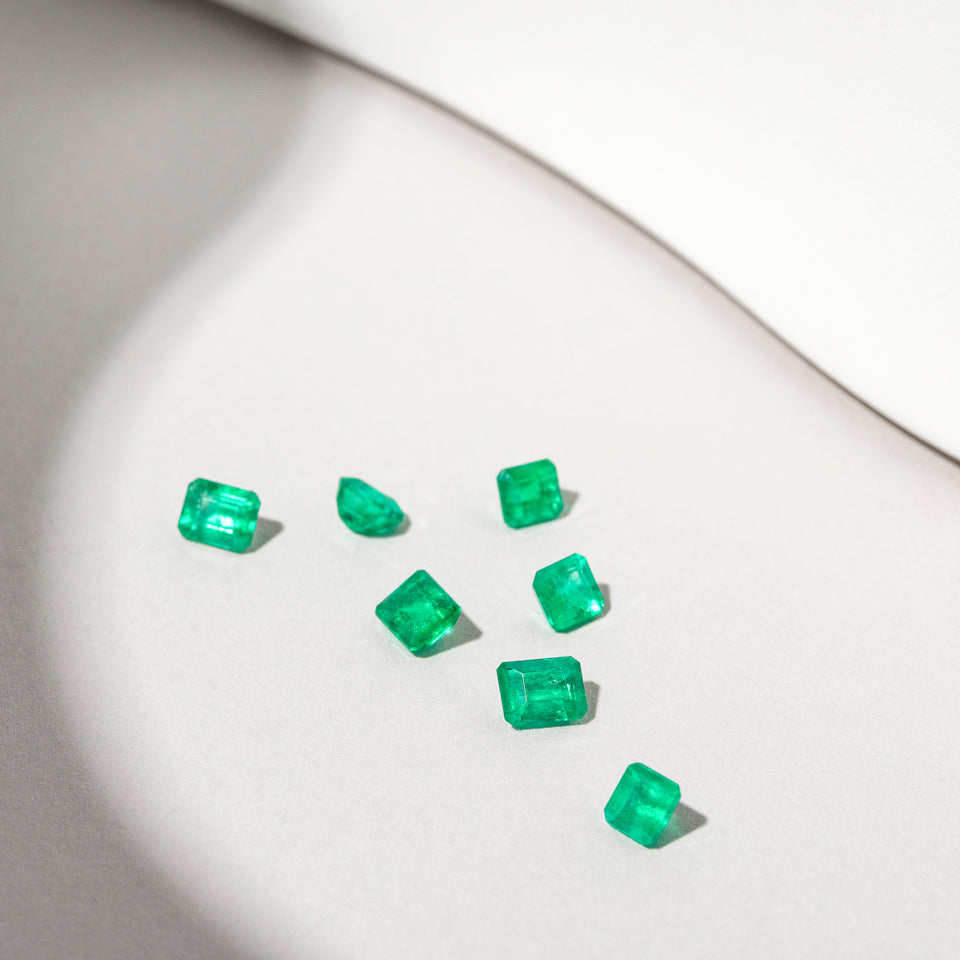
Emeralds
Collapsible content
Description
Prized for their lush green color and legend of mystical powers, including protection against evil, emeralds have been mined since antiquity and cherished by the likes of Cleopatra and Elizabeth Taylor. The deeper or more green its hue, the more valuable it is (the rarest ones will appear intensely green-blue). Emeralds typically contain visible inclusions, so eye-clean emeralds are rare and valuable. We do use untreated and minimally oiled emeralds but most often use oiled emeralds; untreated emeralds are rare and quite valuable.
Origins
The majority of the emeralds we use are from Colombia, although emeralds are found in Brazil, Afghanistan and Zambia.
Care
Emeralds are naturally brittle and may be more fragile because of naturally occurring inclusions. Heat, chemicals and intense light can amplify these fractures. Avoid impact, extended pressure and extreme temperatures when wearing them to prevent chipping or cracking. Gently clean with appropriate jewelry cleaner and a soft brush. A very gentle, fragrance-free soap can be used. If your emerald is oiled, it’s important to re-oil it to preserve its appearance. For more information, visit our Care Guide.
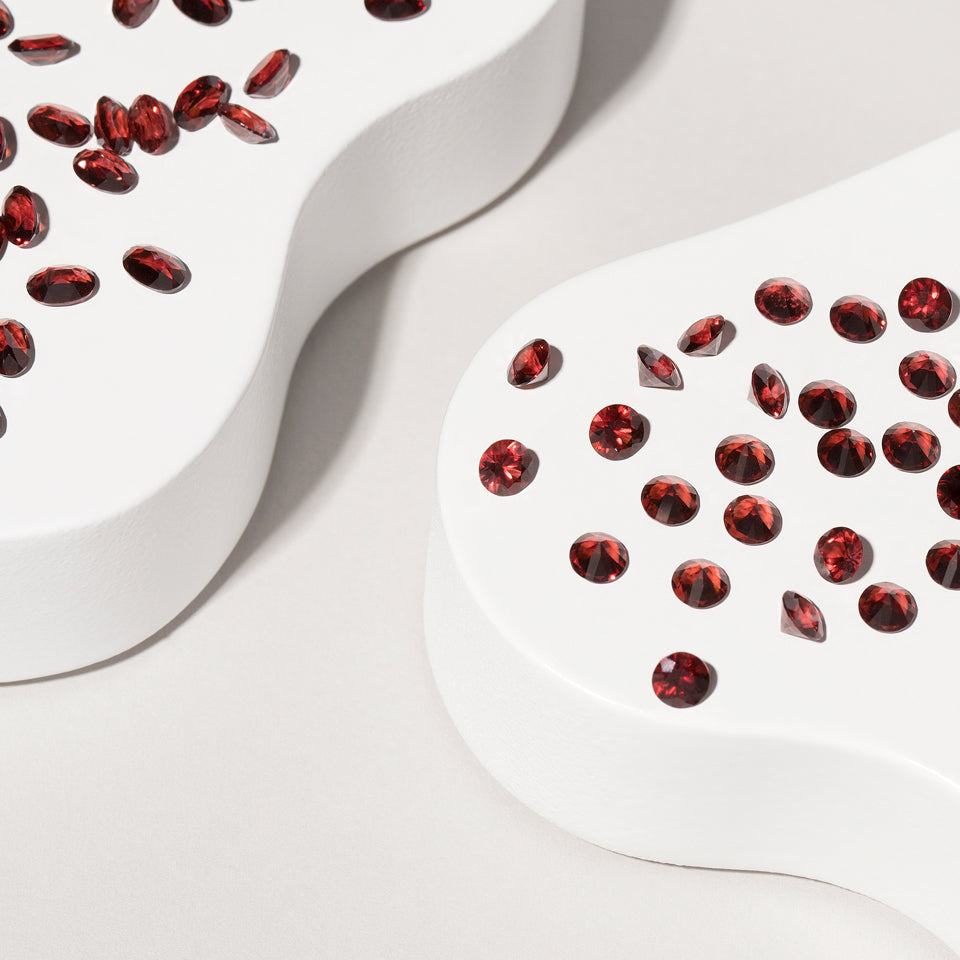
Garnets
Collapsible content
Description
Garnets are a group of minerals that come in a spectrum of colors and have been used as inlays in jewelry and protective talismans since ancient times. Through medieval and modern history, healers and royalty alike believed garnets had the power to shield their wearers from harm. Red garnets are traditionally known as January's birthstone, but we work with a rich palette of colors, including pink and peach, plus vibrant green Tsavorites and deeply saturated Ant Hill garnets.
Origins
Garnets can be found throughout the world but most commonly come from Mexico and Africa, specifically Kenya, Tanzania and Madagascar. We proudly work with Ant Hill garnets (mostly found in Arizona), which are mined and hauled to the surface by ants while excavating their underground passages. Native Americans first discovered them and sewed them into ceremonial rattles, or gifted them as tokens of appreciation. Today the mining process involves scooping them off the ground, causing no harm to the environment or the ants.
Care
Jewelry cleaner is always safe for cleaning garnets. For more info, contact our store.
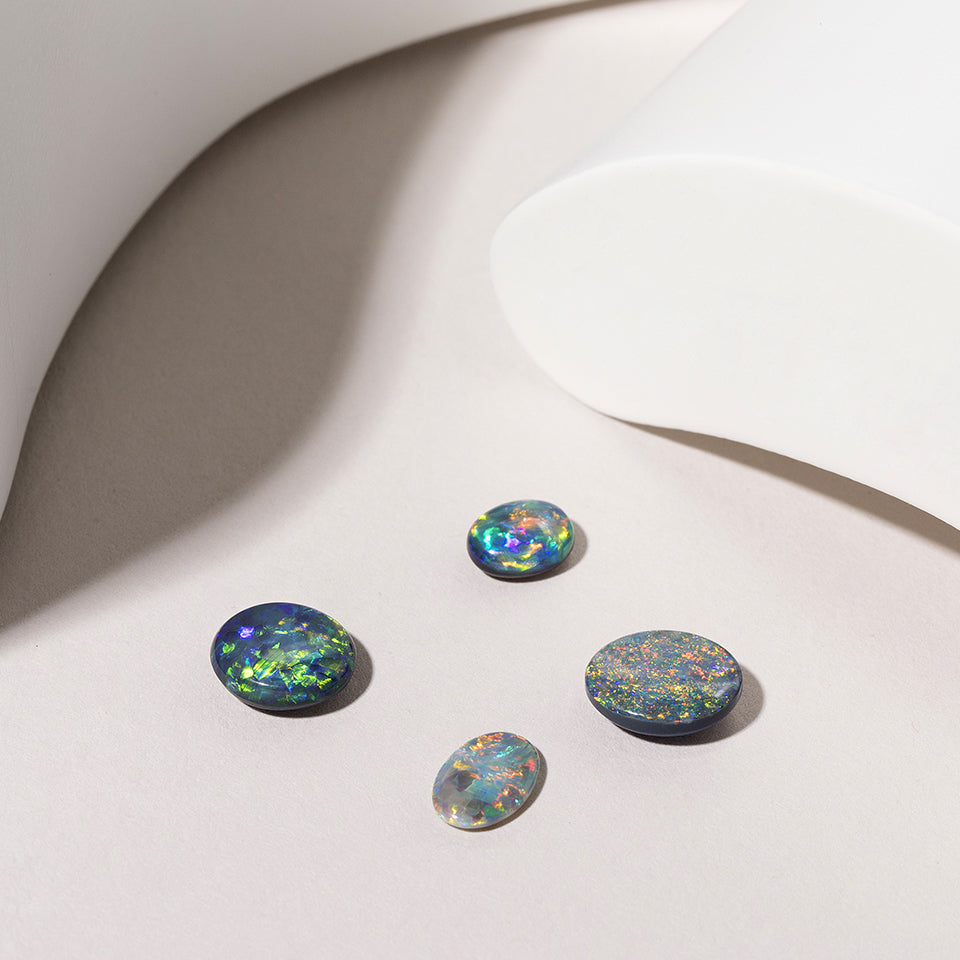
Opals
Collapsible content
Description
The name "opal" originates from the Greek word "opallios," which means "to see a change in color." A precious opal's microscopic array of silica spheres diffract light into a kaleidoscope of flashing colors, creating its multidimensional appearance. On the other hand, a common opal does not display play-of-color. In ancient times, opals symbolized fidelity and today is said to amplify one's truest self.
Origins
We work with a range of opals, including white, black and boulder opals from Australia, pink opals from Peru and a small amount of opals from Ethiopia and Oregon, USA. While opals can also be found in Mexico and Brazil, Australia is the world’s primary source for this semi-precious stone.
Care
Opals are extremely delicate and should be worn with special attention to our care instructions, including storage, as they can become dry and are more susceptible to damage if stored improperly. They are best kept in a soft cloth dabbed with a few drops of water. Because of their softness, opals are excellent choices for earrings, necklaces or special occasion rings. We do not recommend them for engagement or everyday rings. For more information, visit our Care Guide.
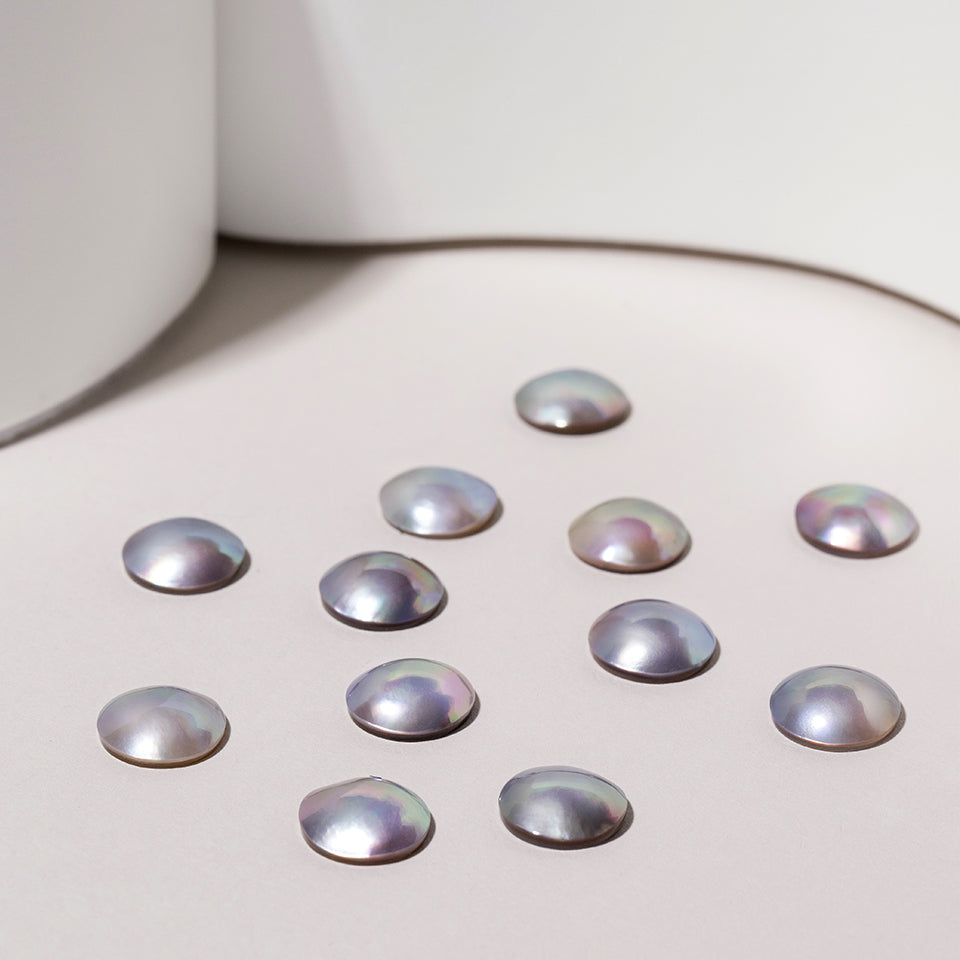
Pearls
Collapsible content
Description
Pearls are a symbol of purity and fertility, and come in a range of colors, from white and cream to light gray and platinum to pink, purple, gold and black. While every mollusk can produce a pearl, only 1 in 10,000 produce a pearl naturally. Cultured pearls are formed in the same process. The only difference is that it begins by inserting an irritant into the mollusk to form the pearl. Careful nurturing, hours of labor and significant investment are needed to bring a cultured pearl to market. Pearls from mollusks such as the queen conch, giant clam and melo melo have not yet been successfully cultured. Naturally occuring, matching pairs of pearls or desirable shapes like teardrops and cabochon are rare and valuable.
Origins
We most often use responsibly cultured pearls from the Tennessee River that are never bleached or dyed, maintaining their natural beauty and durability. We also use cultured saltwater pearls from the rainbow-lipped oyster in the Sea of Cortez – a close relative of the black-lipped oyster that produces Tahitian pearls – as well as conch pearls produced by queen conch mollusks, which are found in parts of the Caribbean and prized for their rarity. We exclusively use pearls that are 100% sustainably cultured or deadstock pearls.
Care
Pearls are durable, but organic and must be protected from chemicals and oils. Store in a cloth and keep away from other jewelry. Clean gently with a soft, damp cloth, and never use an ultrasonic or steam cleaner. Pearls should be the last thing on and the first thing off. For more information, visit our Care Guide.
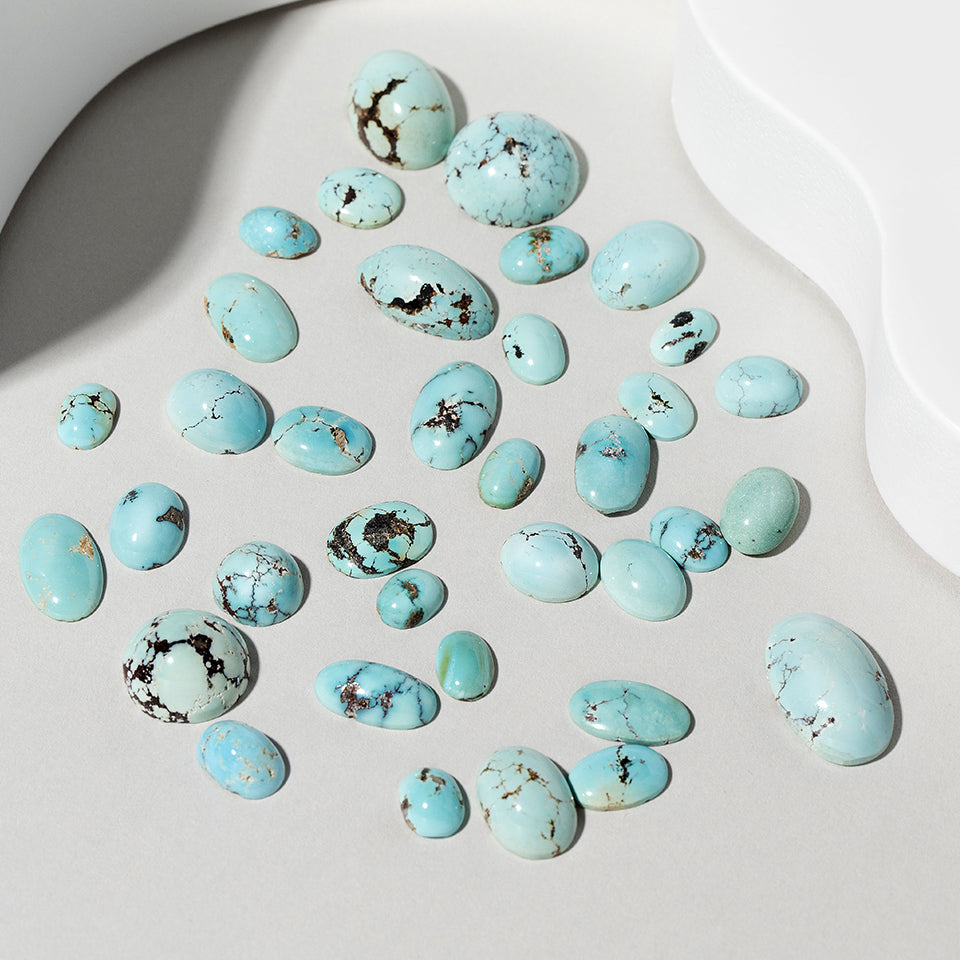
Turquoise
Collapsible content
Description
Turquoise was being carved by ancient artisans more than 3,000 years ago and has long been considered a symbol of good fortune, prosperity and protection. It comes in varying shades of blue-green, depending on copper and iron content, and is relatively soft, making it ideal for cutting into cabochons or flat pieces for inlays.
Origins
We predominantly work with real, 100% pure (meaning completely natural, untreated and undyed) Sleeping Beauty turquoise from the now-closed Sleeping Beauty mine in Arizona. We also have a limited supply of rare Persian turquoise from the also closed Mashhad Mine in Iran.
Care
All natural turquoise jewelry may change color with age or depending on the body chemistry of the wearer. Exposure to lotions, perfumes, oils or cleaning agents will quickly cause noticeable change and in some cases, damage. If contact occurs, clean gently with fingertips, our jewelry cleaner (or a mild fragrance-free soap and lukewarm water). Otherwise, gently clean with a dry cloth. Because of its softness, turquoise is an excellent choice for earrings, necklaces or special occasion rings. We don’t recommend it for engagement or everyday rings. For more information, visit our Care Guide.
Metals
Overview
Gold is most coveted for its aesthetic qualities and malleability. Its purity is measured in karats: one karat represents 1/24 of the whole, so 24k means 100% pure, naturally yellow gold. 24k gold is too soft for everyday wear, so for our jewelry, we recommend platinum and 14k or 18k gold, which is pure gold mixed with other metals, creating a stronger, more durable alloy. We love working with richly-colored 22k gold for jewelry that does not contain any stones.
We are happy to discuss requests for any desired materials in addition to the metals listed here.
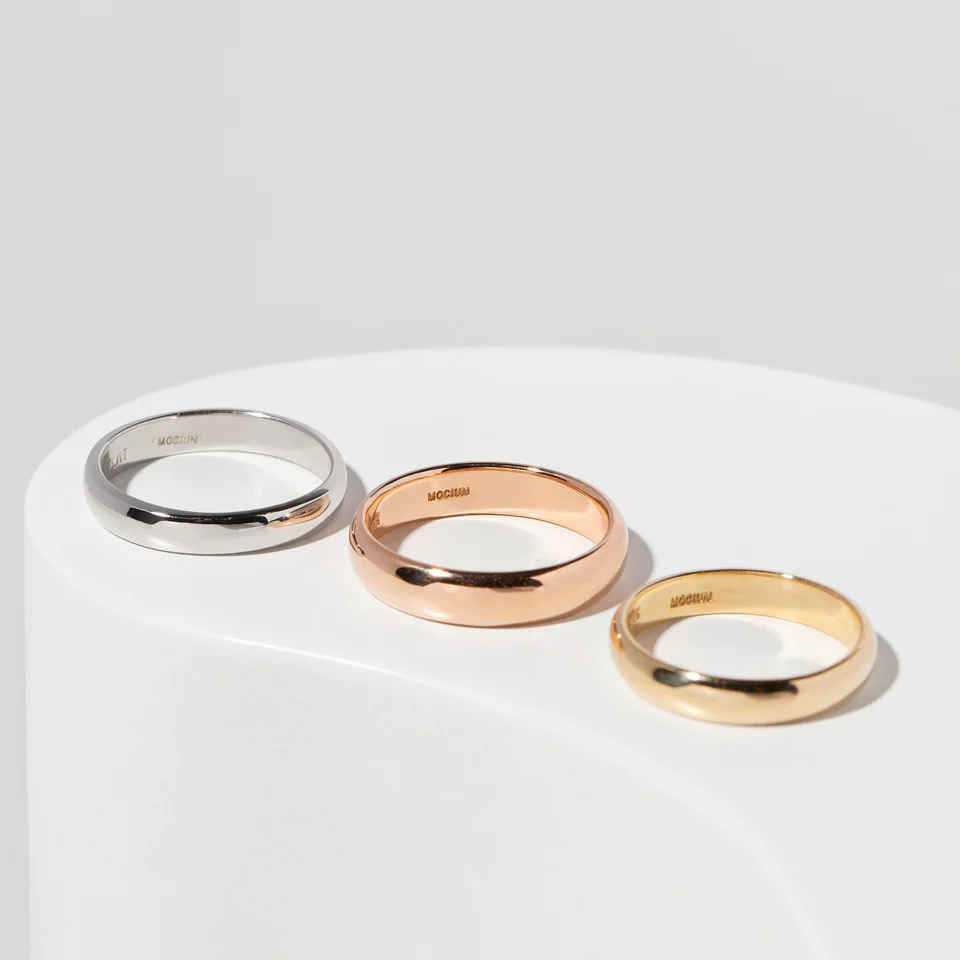
Collapsible content
Yellow Gold
Made of pure gold and alloy metals like copper and zinc, yellow gold is hypoallergenic and easy to maintain. We love using yellow gold with all gemstones and diamonds.
Rose Gold
Rose gold is made of pure gold alloyed with copper, which gives it its reddish tint (perfect for warm-colored and pink gemstones or diamonds) and adds durability. It is not a hypoallergenic metal.
White Gold
White gold is an alloy of pure gold and white metals such as nickel, silver and palladium. This metal pairs best with cool-colored gems, as well as colorless to near-colorless diamonds. It is not a hypoallergenic metal and not recommended if you have a nickel sensitivity. Unless requested, we do not rhodium-plate our white gold to honor its naturally yellow undertones.
Platinum
First popularized with Edwardian engagement rings, the rare and extremely durable platinum comes at a higher cost than gold. Platinum has cool, blue undertones and is a pure element. This hypoallergenic metal can be used over white gold for those with nickel sensitivity.
Responsibility
We strive to use 100% responsibly sourced, eco-friendly or recycled gold when possible. Our precious metals are currently cast in New York City by a trusted network of partners whose practices align with our philosophy on responsible jewelry-making and guarantee nimble timelines and fair pricing. At this time, we are in the process of finding a partner that uses recycled metals in addition to recycled gold to create a certified 100% recycled alloy. Please contact us if you have any questions about our precious metals.
We are here to support treasure hunters on their search for the rare, the beautiful and the enduring.

